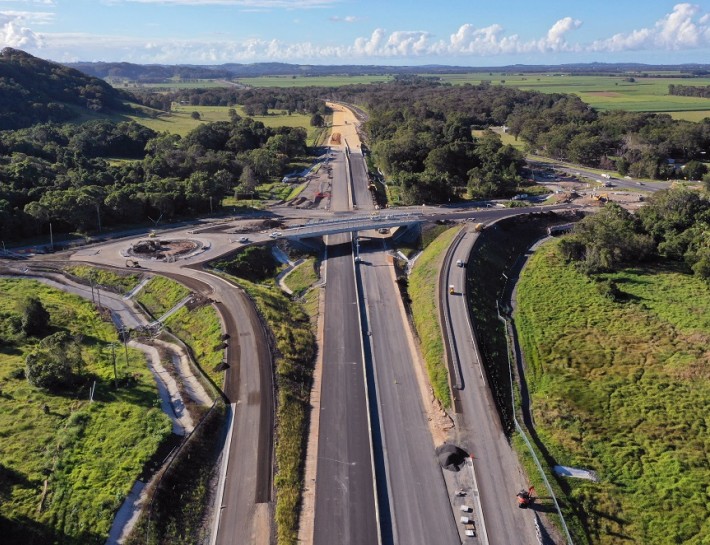Centre for Geotechnical Science and Engineering

Bayesian back analysis for settlement prediction of embankments built on soft soils
BAYESIAN BACK ANALYSIS FOR SETTLEMENT PREDICTION OF EMBANKMENTS BUILT ON SOFT SOILS
Key Researchers: Jinsong Huang, Richard Kelly, Patrick Wong
PROBLEM DESCRIPTION
Despite many years of experience with the Pacific Highway Upgrade there are many examples where fills have settled more than expected during construction and after road opening. This causes potential delay delivering projects, ponding, potential aquaplaning and unexpected maintenance. Examples are elements of the Ballina Bypass, Woolgoolga to Ballina, Nambucca to Urunga and the Tugun Bypass in NSW; Gateway Upgrade, Gateway Upgrade North and the Northern Access Road Project in Brisbane.
Inappropriate hold point release is a large contributor to poor outcomes, particularly when coupled with tight construction programs and deep soft soils.
Hold points are released after an assessment is performed to demonstrate that actual settlement performance meets design expectations. If settlement is allowed to continue for a long period of time it is possible to be highly confident in future performance. However, construction programmes usually do not have enough time and the assessment needs to be performed on a relatively limited data set.
Hyperbolic and Asaoka methods are commonly used to provide a general indication of progress for a uniform material deposit. However, these methods only become accurate after a relatively long time has passed (60% consolidation) and can be misleading for less uniform deep deposits of soft clay particularly when rates of consolidation with depth are variable. These graphical methods are also limited to relatively simple fill staging, and cannot be used to predict embankment performance after unloading.
More sophisticated time-settlement back analysis is also performed where the monitoring data is fitted by numerical calculations. There is a near infinite number of solutions that can fit the monitoring data and the success of the back analysis depends on the engineering judgement and skill of the analyst. In addition, there is a trend of ignoring pore pressures because it is supposedly too hard to fit pore pressure and settlement. The Ballina Bypass vacuum embankment and Gateway Upgrade are examples where post construction settlements were larger than expected and pore pressures were explicitly stated to be ignored in the assessments. The recent Numerical Prediction Symposium for the Ballina trial embankment demonstrated that prediction and back analysis of settlements is difficult and that even industry leaders struggle to obtain accurate back analyses.
SCIENTIFIC AND ENGINEERING APPROACHES
The Bayesian approach is a statistically based method that finds the most probable fit to the monitoring data conditional on the adopted geotechnical material parameters and measurement errors. Bayesian methods are a key component of artificial intelligence and machine learning systems.
- The Bayesian method can fit both settlement and pore pressure measurements. Typically the compression parameters increase which is reasonable if sample disturbance has affected the quality of the laboratory test data, which is the usual state of practice. Fitting all of the data increases confidence that embankment performance is known.
- The Bayesian back analysis converges to a solution approximately 1/3rd of the way through the consolidation process. The analysis could be run say every month during a project and once convergence occurs contractors can gain increasing confidence in the outcome and can make decisions about whether to add fill or release hold points relatively early in the process.
- The Bayesian approach gives measures of uncertainty in the forms of standard deviations and output probability distributions. This is data that currently is not provided when conventional methods are used. This sort of information can be used in risk assessments.
APPLICATIONS
- Current industry practices when releasing hold points for surcharge removal and pavement construction do not appear to be consistently adequate. The availability of the Bayesian Updating method to the industry will allow them to assess confidence levels of prediction.
- Improve the quality of back analysis and allow decisions regarding the progress of settlement to be made with confidence relatively early during construction. This will enable the key stake holders to assess program and performance risk early, and make informed decisions to implement remedial strategies (e.g. placement of additional surcharge) before it is too late.
- Increase confidence that whole-of-life settlement performance will be achieved. The Bayesian updating method can be extended to back analysis of monitoring data following removal of surcharge and even long-term performance of the roadway so long as settlement monitoring continues.
- The method has the potential to be extended to other engineering applications, including monitoring and deformation performance prediction of internal settlement of high fills, lateral deformation of retaining walls and movement of meta-stable cuttings, embankment and natural slopes.

The University of Newcastle acknowledges the traditional custodians of the lands within our footprint areas: Awabakal, Darkinjung, Biripai, Worimi, Wonnarua, and Eora Nations. We also pay respect to the wisdom of our Elders past and present.
